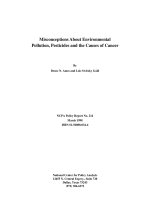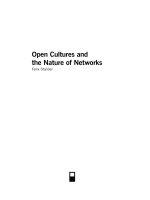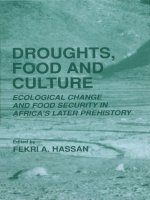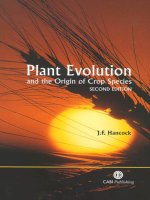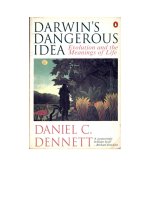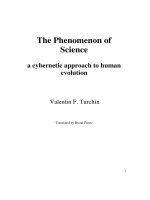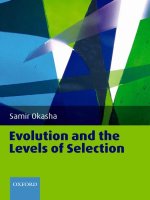Teaching About Evolution and the Nature of Science - NAP (2004) Episode 1 ppsx
Bạn đang xem bản rút gọn của tài liệu. Xem và tải ngay bản đầy đủ của tài liệu tại đây (931.71 KB, 15 trang )
NATIONAL ACADEMY PRESS
Washington, DC
TEACHING ABOUT
EVOLUTION
AND THE
NATURE OF
SCIENCE
Copyright 2004 © National Academy of Sciences. All rights reserved.
Unless otherwise indicated, all materials in this PDF File provided by the National Academies Press (www.nap.edu) for research
purposes are copyrighted by the National Academy of Sciences. Distribution, posting, or copying is strictly prohibited without
written permission of the NAP.
Generated for on Sat Oct 9 17:18:26 2004
/>ii
•
NATIONAL ACADEMY PRESS 2101 Constitution Avenue, NW Washington, DC 20418
The National Academy of Sciences is a private, nonprofit, self-perpetuating society of distin-
guished scholars engaged in scientific and engineering research, dedicated to the furtherance
of science and technology and to their use for the general welfare. Upon the authority of the
charter granted to it by the Congress in 1863, the Academy has a mandate that requires it to
advise the federal government on scientific and technical matters.
Library of Congress Cataloging-in-Publication Data
Teaching about evolution and the nature of science / [Working Group on
Teaching Evolution, National Academy of Sciences].
p. cm.
Includes bibliographical references and index.
ISBN 0-309-06364-7 (pbk.)
1. Evolution (Biology)—Study and teaching. 2. Science—Study and
teaching. I. National Academy of Sciences (U.S.). Working Group
on Teaching Evolution.
QH362.T435 1998
576.8′071—dc21 98-16100
CIP
Printed in the United States of America
Copyright 1998 by the National Academy of Sciences. All rights reserved.
Teaching About Evolution and the Nature of Science is available for sale from the
National Academy Press, 2101 Constitution Avenue, NW, Box 285, Washington, DC 20055.
Call 1-800-624-6242 or 202-334-3313 (in the Washington Metropolitan Area).
The report is also available online at www.nap.edu/readingroom/books/evolution98
Copyright 2004 © National Academy of Sciences. All rights reserved.
Unless otherwise indicated, all materials in this PDF File provided by the National Academies Press (www.nap.edu) for research
purposes are copyrighted by the National Academy of Sciences. Distribution, posting, or copying is strictly prohibited without
written permission of the NAP.
Generated for on Sat Oct 9 17:18:26 2004
/>Donald Kennedy (Chairman)
Bing Professor of Environmental Studies
Stanford University
Stanford, California
Bruce Alberts
President
National Academy of Sciences
Washington, DC
Danine Ezell
Science Department
Bell Junior High School
San Diego, California
Tim Goldsmith
Department of Biology
Yale University
New Haven, Connecticut
Robert Hazen
Staff Scientist, Geophysical Laboratory
Carnegie Institution of Washington
Washington, DC
Norman Lederman
Professor, College of Science
Science and Mathematics Education
Oregon State University
Corvallis, Oregon
Joseph McInerney
Director
Biological Sciences Curriculum Study
Colorado Springs, Colorado
John Moore
Professor Emeritus of Biology
University of California
Riverside, California
Eugenie Scott
Executive Director
National Center for Science Education
El Cerrito, California
Maxine Singer
President
Carnegie Institution of Washington
Washington, DC
Mike Smith
Associate Professor of Medical Education
Mercer University School of Medicine
Macon, Georgia
Marilyn Suiter
Director, Education and Human Resources
American Geological Institute
Alexandria, Virginia
Rachel Wood
Science Specialist
Delaware State Department of Public
Instruction
Dover, Delaware
•
iii
WORKING GROUP ON TEACHING EVOLUTION
STAFF OF THE CENTER FOR SCIENCE, MATHEMATICS, AND ENGINEERING EDUCATION:
Rodger Bybee, Executive Director
Peggy Gill, Research Assistant
Jay Hackett, Visiting Fellow
Patrice Legro, Division Director
Steve Olson, Consultant Writer
Copyright 2004 © National Academy of Sciences. All rights reserved.
Unless otherwise indicated, all materials in this PDF File provided by the National Academies Press (www.nap.edu) for research
purposes are copyrighted by the National Academy of Sciences. Distribution, posting, or copying is strictly prohibited without
written permission of the NAP.
Generated for on Sat Oct 9 17:18:26 2004
/>iv
•
Any opinions, findings, conclusions, or recommendations expressed in this publication
are those of the authors and do not necessarily reflect the view of the organizations that
provided financial support for this project.
THE NATIONAL ACADEMY OF SCIENCES
WASHINGTON, DC
Visit us at
www.nas.edu
Copyright 2004 © National Academy of Sciences. All rights reserved.
Unless otherwise indicated, all materials in this PDF File provided by the National Academies Press (www.nap.edu) for research
purposes are copyrighted by the National Academy of Sciences. Distribution, posting, or copying is strictly prohibited without
written permission of the NAP.
Generated for on Sat Oct 9 17:18:26 2004
/>•
v
Acknowledgments
The National Academy of Sciences gratefully acknowledges contributions from:
Howard Hughes Medical Institute
The Esther A. and Joseph Klingenstein Fund, Inc.
The Council of the National Academy of Sciences
The 1997 Annual Fund of the National Academy of Sciences,
whose donors include
NAS members and other science-interested individuals.
We also extend special thanks to members of the
Council of State Science Supervisors
and teachers who participated in focus groups and provided guidance
on the development of this document.
Copyright 2004 © National Academy of Sciences. All rights reserved.
Unless otherwise indicated, all materials in this PDF File provided by the National Academies Press (www.nap.edu) for research
purposes are copyrighted by the National Academy of Sciences. Distribution, posting, or copying is strictly prohibited without
written permission of the NAP.
Generated for on Sat Oct 9 17:18:26 2004
/>Copyright 2004 © National Academy of Sciences. All rights reserved.
Unless otherwise indicated, all materials in this PDF File provided by the National Academies Press (www.nap.edu) for research
purposes are copyrighted by the National Academy of Sciences. Distribution, posting, or copying is strictly prohibited without
written permission of the NAP.
Generated for on Sat Oct 9 17:18:26 2004
/>• viii •
Preface
• 1 •
CHAPTER 1
Why Teach Evolution?
Dialogue: The Challenge to Teachers 7
• 11 •
CHAPTER 2
Major Themes in Evolution
Dialogue: Teaching About the Nature of Science 22
• 27 •
CHAPTER 3
Evolution and the Nature of Science
Dialogue: Teaching Evolution Through Inquiry 44
• 47 •
CHAPTER 4
Evolution and the National Science Education Standards
• 55 •
CHAPTER 5
Frequently Asked Questions About Evolution and the
Nature of Science
• 61 •
CHAPTER 6
Activities for Teaching About Evolution and the
Nature of Science
• 105 •
CHAPTER 7
Selecting Instructional Materials
Appendices
A. Six Significant Court Decisions Regarding Evolution and Creationism Issues 121
B. Excerpt from “Religion in the Public Schools: A Joint Statement of Current Law,” 123
C. Three Statements in Support of Teaching Evolution from Science and Science Education
Organizations 124
D. References for Further Reading and Other Resources 130
E. Reviewers 133
• 135 •
Index
Contents
Copyright 2004 © National Academy of Sciences. All rights reserved.
Unless otherwise indicated, all materials in this PDF File provided by the National Academies Press (www.nap.edu) for research
purposes are copyrighted by the National Academy of Sciences. Distribution, posting, or copying is strictly prohibited without
written permission of the NAP.
Generated for on Sat Oct 9 17:18:26 2004
/>In a 1786 letter to a friend, Thomas
Jefferson called for “the diffusion of knowl-
edge among the people. No other sure foun-
dation can be devised for the preservation of
freedom and happiness.”
1
Jefferson saw clear-
ly what has become increasingly evident since
then: the fortunes of a nation rest on the
ability of its citizens to understand and use
information about the world around them.
We are about to enter a century in which
the United States will be even more depen-
dent on science and technology than it has
been in the past. Such a future demands a
citizenry able to use many of the same skills
that scientists use in their work—close obser-
vation, careful reasoning, and creative think-
ing based on what is known about the world.
The ability to use scientific knowledge and
ways of thinking depends to a considerable
extent on the education that people receive
from kindergarten through high school. Yet
the teaching of science in the nation’s public
schools often is marred by a serious omission.
Many students receive little or no exposure to
the most important concept in modern biolo-
gy, a concept essential to understanding key
aspects of living things—biological evolution.
People and groups opposed to the teaching of
evolution in the public schools have pressed
teachers and administrators to present ideas
that conflict with evolution or to teach evolu-
tion as a “theory, not a fact.” They have per-
suaded some textbook publishers to downplay
or eliminate treatments of evolution and have
championed legislation and policies at the
state and local levels meant to discourage the
teaching of evolution.
These pressures have contributed to
widespread misconceptions about the state of
biological understanding and about what is
and is not science. Fewer than one-half of
American adults believe that humans evolved
from earlier species.
2
More than one half of
Americans say that they would like to have
creationism taught in public school class-
rooms
3
—even though the Supreme Court
has ruled that “creation science” is a religious
idea and that its teaching cannot be mandat-
ed in the public schools.
4
The widespread misunderstandings about
evolution and the conviction that creationism
should be taught in science classes are of
great concern to the National Academy of
Sciences, a private nonpartisan group of
1,800 scientists dedicated to the use of sci-
ence and technology for the general welfare.
The Academy and its affiliated institutions—
the National Academy of Engineering, the
Institute of Medicine, and the National
Research Council—have all sought to
counter misinformation about evolution
because of the enormous body of data sup-
porting evolution and because of the impor-
tance of evolution as a central concept in
understanding our planet.
The document that you are about to read
is addressed to several groups at the center of
the ongoing debate over evolution: the
teachers, other educators, and policy makers
who design, deliver, and oversee classroom
instruction in biology. It summarizes the
overwhelming observational evidence for evo-
lution and suggests effective ways of teaching
the subject. It explains the nature of science
and describes how science differs from other
human endeavors. It provides answers to fre-
quently asked questions about evolution and
the nature of science and offers guidance on
how to analyze and select teaching materials.
This publication does not attempt specifi-
cally to refute the ideas proffered by those
who oppose the teaching of evolution in pub-
lic schools. A related document, Science and
Creationism: A View from the National
Academy of Sciences, discusses evolution and
“creation science” in detail.
5
This publication
instead provides information and resources
that teachers and administrators can use to
inform themselves, their students, parents,
and others about evolution and the role of
science in human affairs.
One source of resistance to the teaching
of evolution is the belief that evolution con-
flicts with religious principles. But accepting
evolution as an accurate description of the
history of life on earth does not mean reject-
ing religion. On the contrary, most religious
communities do not hold that the concept of
evolution is at odds with their descriptions of
creation and human origins.
Nevertheless, religious faith and scientific
knowledge, which are both useful and impor-
Teaching About
Evolution and the Nature of Science
viii
•
Preface
Copyright 2004 © National Academy of Sciences. All rights reserved.
Unless otherwise indicated, all materials in this PDF File provided by the National Academies Press (www.nap.edu) for research
purposes are copyrighted by the National Academy of Sciences. Distribution, posting, or copying is strictly prohibited without
written permission of the NAP.
Generated for on Sat Oct 9 17:18:26 2004
/>tant, are different. This publication is
designed to help ensure that students receive
an education in the sciences that reflects this
distinction.
The book is divided into seven chapters
and five appendices, plus three interspersed
“dialogues” in which several fictional teachers
discuss the implications of the ideas discussed
in the book.
• Chapter 1, “Why Teach Evolution,”
introduces the basic concepts of evolutionary
theory and provides scientific definitions of
several common terms, such as “theory” and
“fact,” used throughout the book.
• The first dialogue, “The Challenge to
Teachers,” follows the conversation of three
teachers as they discuss some of the prob-
lems that can arise in teaching evolution and
the nature of science.
• Chapter 2, “Major Themes in Evolution,”
provides a general overview of evolutionary
processes, describes the evidence supporting
evolution, and shows how evolutionary theory
is related to other areas of biology.
• The second dialogue, “Teaching About
the Nature of Science,” follows the three
teachers as they engage in a teaching exercise
designed to demonstrate several prominent
features of science.
• Chapter 3, “Evolution and the Nature
of Science,” uses several scientific theories,
including evolution, to highlight important
characteristics of scientific endeavors.
• The third dialogue, “Teaching Evolution
Through Inquiry,” presents a teacher using an
exercise designed to interest and educate her
students in fossils and the mechanisms of
evolution.
• Chapter 4, “Evolution and the National
Science Education Standards,” begins by
describing the recent efforts to specify what
students should know and be able to do as a
result of their education in the sciences. It
then reproduces sections from the 1996
National Science Education Standards
released by the National Research Council
that relate to biological evolution and the
nature and history of science.
• Chapter 5, “Frequently Asked Questions
About Evolution and the Nature of Science,”
gives short answers to some of the questions
asked most frequently by students, parents,
educators, and others.
• Chapter 6, “Activities for Teaching
About Evolution and the Nature of Science,”
provides eight sample activities that teachers
can use to develop students’ understanding of
evolution and scientific inquiry.
• Chapter 7, “Selecting Instructional
Materials,” lays out criteria that can be used
to evaluate school science programs and the
content and design of instructional materials.
• The appendices summarize significant
court decisions regarding evolution and cre-
ationism issues, reproduce statements from a
number of organizations regarding the teach-
ing of evolution, provide references for fur-
ther reading and other resources, and con-
clude with a list of reviewers.
Teaching About Evolution and the Nature
of Science was produced by the Working
Group on Teaching Evolution under the
Council of the National Academy of Sciences.
The Working Group consists of 13 scientists
and educators who have been extensively
involved in research and education on evolu-
tion and related scientific subjects. The group
worked closely with teachers, school adminis-
trators, state officials, and others in preparing
this publication, soliciting suggestions for what
would be most useful, and responding to com-
ments on draft materials. We welcome addi-
tional input and guidance from readers that
we can incorporate into future versions of this
publication. Please visit our World Wide Web
site at www4.nas.edu/opus/evolve.nsf for
additional information.
NOTES
1. Thomas Jefferson, To George Wythe, “Crusade
Against Ignorance” in
Thomas Jefferson on
Education,
ed. Gordon C. Lee. 1961. New York:
Teachers College Press, pp. 99-100.
2. National Science Board. 1996.
Science and
Engineering Indicators
—1996. Washington, DC:
U.S. Government Printing Office.
3. Gallup Poll, News Release, May 24, 1996.
4. In the 1987 case
Edwards v. Aguillard, the U.S.
Supreme Court reaffirmed the 1982 decision of a
federal district court that the teaching of “creation
science” in public schools violates the First
Amendment of the U.S. Constitution.
5. National Academy of Sciences. (in press).
Science
and Creationism: A View from the National
Academy of Sciences.
Washington, DC: National
Academy Press. (See www.nap.edu)
•
ix
Preface
Copyright 2004 © National Academy of Sciences. All rights reserved.
Unless otherwise indicated, all materials in this PDF File provided by the National Academies Press (www.nap.edu) for research
purposes are copyrighted by the National Academy of Sciences. Distribution, posting, or copying is strictly prohibited without
written permission of the NAP.
Generated for on Sat Oct 9 17:18:26 2004
/>Copyright 2004 © National Academy of Sciences. All rights reserved.
Unless otherwise indicated, all materials in this PDF File provided by the National Academies Press (www.nap.edu) for research
purposes are copyrighted by the National Academy of Sciences. Distribution, posting, or copying is strictly prohibited without
written permission of the NAP.
Generated for on Sat Oct 9 17:18:26 2004
/>W
hy is it so important
to teach evolution?
After all, many ques-
tions in biology can be answered
without mentioning evolution: How
do birds fly? How can certain plants
grow in the desert? Why do children resem-
ble their parents? Each of these questions
has an immediate answer involving aerody-
namics, the storage and use of water by
plants, or the mechanisms of heredity.
Students ask about such things all the time.
The answers to these questions often
raise deeper questions that are sometimes
asked by students: How did things come to
be that way? What is the advantage to birds
of flying? How did desert plants come to
differ from others? How did an individual
organism come to have its particular genetic
endowment? Answering questions like these
requires a historical context—a framework
of understanding that recognizes change
through time.
People who study nature closely have
always asked these kinds of questions. Over
time, two observations have proved to be
especially perplexing. The older of these
has to do with the diversity of life: Why
are there so many different kinds of plants
and animals? The more we explore the
world, the more impressed we are with the
multiplicity of kinds of organisms. In the
mid-nineteenth century, when Charles
Darwin was writing
On the Origin of
Species
, naturalists recognized several tens
of thousands of different plant and animal
species. By the middle of the twentieth
century, biologists had paid more attention
to less conspicuous forms of life,
from insects to microorganisms,
and the estimate was up to 1 or
2 million. Since then, investiga-
tions in tropical rain forests—the
center of much of the world’s biological
diversity—have multiplied those estimates at
least tenfold. What process has created this
extraordinary variety of life?
The second question involves the inverse
of life’s diversity. How can the similarities
among organisms be explained? Humans
have always noticed the similarities among
closely related species, but it gradually
became apparent that even distantly related
species share many anatomical and functional
characteristics. The bones in a whale’s front
flippers are arranged in much the same way
as the bones in our own arms. As organisms
grow from fertilized egg cells into embryos,
they pass through many similar developmen-
tal stages. Furthermore, as paleontologists
studied the fossil record, they discovered
countless extinct species that are clearly
related in various ways to organisms living
today.
This question has emerged with even
greater force as modern experimental biolo-
gy has focused on processes at the cellular
and molecular level. From bacteria to yeast
to mice to humans, all living things use the
same biochemical machinery to carry out
the basic processes of life. Many of the
proteins that make up cells and catalyze
chemical reactions in the body are virtually
identical across species. Certain human
genes that code for proteins differ little
from the corresponding genes in fruit flies,
Why Teach Evolution?
1
Copyright 2004 © National Academy of Sciences. All rights reserved.
Unless otherwise indicated, all materials in this PDF File provided by the National Academies Press (www.nap.edu) for research
purposes are copyrighted by the National Academy of Sciences. Distribution, posting, or copying is strictly prohibited without
written permission of the NAP.
Generated for on Sat Oct 9 17:18:26 2004
/>mice, and primates. All living things use
the same biochemical system to pass genet-
ic information from one generation to
another.
From a scientific standpoint, there is
one compelling answer to questions about
life’s commonalities. Different kinds of
organisms share so many characteristics of
structure and function because they are
related to one another. But how?
Solving the Puzzle
The concept of biological evolution
addresses both of these fundamental ques-
tions. It accounts for the relatedness
among organisms by explaining that the
millions of different species of plants, ani-
mals, and microorganisms that live on earth
today are related by descent from common
ancestors—like distant cousins. Organisms
in nature typically produce more offspring
than can survive and reproduce given the
constraints of food, space, and other
resources in the environment. These off-
spring often differ from one another in ways
that are heritable—that is, they can pass on
the differences genetically to their own off-
spring. If competing offspring have traits
that are advantageous in a given environ-
ment, they will survive and pass on those
traits. As differences continue to accumu-
late over generations, populations of organ-
isms diverge from their ancestors.
This straightforward process, which is a
natural consequence of biologically repro-
ducing organisms competing for limited
resources, is responsible for one of the most
magnificent chronicles known to science.
Over billions of years, it has led the earliest
organisms on earth to diversify into all of
the plants, animals, and microorganisms
that exist today. Though humans, fish, and
bacteria would seem to be so different as to
defy comparison, they all share some of the
characteristics of their common ancestors.
Evolution also explains the great diversity
of modern species. Populations of organisms
Teaching About
Evolution and the Nature of Science
2
•
Investigations of forest ecosystems have helped reveal
the incredible diversity of earth's living things.
Copyright 2004 © National Academy of Sciences. All rights reserved.
Unless otherwise indicated, all materials in this PDF File provided by the National Academies Press (www.nap.edu) for research
purposes are copyrighted by the National Academy of Sciences. Distribution, posting, or copying is strictly prohibited without
written permission of the NAP.
Generated for on Sat Oct 9 17:18:26 2004
/>with characteristics enabling them to occupy
ecological niches not occupied by similar
organisms have a greater chance of surviving.
Over time—as the next chapter discusses in
more detail—species have diversified and
have occupied more and more ecological
niches to take advantage of new resources.
Evolution explains something else as
well. During the billions of years that life
has been on earth, it has played an increas-
ingly important role in altering the planet’s
physical environment. For example, the
composition of our atmosphere is partly a
consequence of living systems. During pho-
tosynthesis, which is a product of evolution,
green plants absorb carbon dioxide and
water, produce organic compounds, and
release oxygen. This process has created
and continues to maintain an atmosphere
rich in oxygen. Living communities also
profoundly affect weather and the move-
ment of water among the oceans, atmos-
phere, and land. Much of the rainfall in the
forests of the western Amazon basin consists
of water that has already made one or more
recent trips through a living plant. In addi-
tion, plants and soil microorganisms exert
important controls over global temperature
by absorbing or emitting “greenhouse gases”
(such as carbon dioxide and methane) that
increase the earth’s capacity to retain heat.
In short, biological evolution accounts
for three of the most fundamental features
of the world around us: the similarities
among living things, the diversity of life, and
many features of the physical world we
inhabit. Explanations of these phenomena
in terms of evolution draw on results from
physics, chemistry, geology, many areas of
biology, and other sciences. Thus, evolution
is the central organizing principle that biolo-
gists use to understand the world. To teach
biology without explaining evolution
deprives students of a powerful concept that
brings great order and coherence to our
understanding of life.
The teaching of evolution also has great
practical value for students. Directly or
indirectly, evolutionary biology has made
many contributions to society. Evolution
explains why many human pathogens have
been developing resistance to formerly
effective drugs and suggests ways of con-
fronting this increasingly serious problem
(this issue is discussed in greater detail in
Chapter 2). Evolutionary biology has also
•
3
CHAPTER 1
Why Teach Evolution?
Living fish and fossil fish
share many similarities,
but the fossil fish clearly
belongs to a different
species that no longer
exists. The progression
of species found in the
fossil record provides
powerful evidence for
evolution.
Fossil fish image not
available in this format
Copyright 2004 © National Academy of Sciences. All rights reserved.
Unless otherwise indicated, all materials in this PDF File provided by the National Academies Press (www.nap.edu) for research
purposes are copyrighted by the National Academy of Sciences. Distribution, posting, or copying is strictly prohibited without
written permission of the NAP.
Generated for on Sat Oct 9 17:18:26 2004
/>contributed to many important agricultural
advances by explaining the relationships
among wild and domesticated plants and
animals and their natural enemies. An
understanding of evolution has been essen-
tial in finding and using natural resources,
such as fossil fuels, and it will be indispens-
able as human societies strive to establish
sustainable relationships with the natural
environment.
Such examples can be multiplied many
times. Evolutionary research is one of the
most active fields of biology today, and dis-
coveries with important practical applica-
tions occur on a regular basis.
Those who oppose the teaching of evo-
lution in public schools sometimes ask that
teachers present “the evidence against evo-
lution.” However, there is no debate within
the scientific community over whether evo-
lution occurred, and there is no evidence
that evolution has not occurred. Some of
the details of how evolution occurs are still
being investigated. But scientists continue
to debate only the particular mechanisms
that result in evolution, not the overall
accuracy of evolution as the explanation of
life’s history.
Evolution and the
Nature of Science
Teaching about evolution has another
important function. Because some people
see evolution as conflicting with widely held
beliefs, the teaching of evolution offers edu-
cators a superb opportunity to illuminate
the nature of science and to differentiate
science from other forms of human endeav-
or and understanding.
Chapter 3 describes the nature of sci-
ence in detail. However, it is important
from the outset to understand how the
meanings of certain key words in science
differ from the way that those words are
used in everyday life.
Think, for example, of how people usually
use the word “theory.” Someone might refer
to an idea and then add, “But that’s only a
theory.” Or someone might preface a remark
by saying, “My theory is . . . .” In common
usage, theory often means “guess” or “hunch.”
In science, the word “theory” means
something quite different. It refers to an
overarching explanation that has been well
substantiated. Science has many other pow-
erful theories besides evolution. Cell theory
says that all living things are composed of
Teaching About
Evolution and the Nature of Science
4
•
20
10
4.6 3.6 2.6 1.6 0.6
Start of rapid O
2
accumulation (Fe
2+
in oceans used up)
Oxygen
Levels in
Atmosphere
(%)
Time
(Billions of Years)
Formation
of the earth
First vertebrates
Present day
Formation of
oceans and
continents
First
living
cells
First photosynthetic
cells
First water-splitting
photosynthesis
releases O
2
Aerobic
respiration
becomes
widespread
Origin of eucaryotic
photosynthetic cells
First multicellular plants
and animals
Living things have
altered the earth's
oceans, land surfaces,
and atmosphere. For
example, photosyn-
thetic organisms are
responsible for the
oxygen that makes up
about a fifth of the
earth's atmosphere.
The rapid accumula-
tion of atmospheric
oxygen about 2 billion
years ago led to the
evolution of more
structured eucaryotic
cells, which in turn
gave rise to multicellu-
lar plants and animals.
Copyright 2004 © National Academy of Sciences. All rights reserved.
Unless otherwise indicated, all materials in this PDF File provided by the National Academies Press (www.nap.edu) for research
purposes are copyrighted by the National Academy of Sciences. Distribution, posting, or copying is strictly prohibited without
written permission of the NAP.
Generated for on Sat Oct 9 17:18:26 2004
/>cells. The heliocentric theory says that the
earth revolves around the sun rather than
vice versa. Such concepts are supported by
such abundant observational and experi-
mental evidence that they are no longer
questioned in science.
Sometimes scientists themselves use the
word “theory” loosely and apply it to tenta-
tive explanations that lack well-established
evidence. But it is important to distinguish
these casual uses of the word “theory” with
its use to describe concepts such as evolu-
tion that are supported by overwhelming
evidence. Scientists might wish that they
had a word other than “theory” to apply to
such enduring explanations of the natural
world, but the term is too deeply engrained
in science to be discarded.
As with all scientific knowledge, a theo-
ry can be refined or even replaced by an
alternative theory in light of new and com-
pelling evidence. For example, Chapter 3
describes how the geocentric theory that
the sun revolves around the earth was
replaced by the heliocentric theory of the
earth’s rotation on its axis and revolution
around the sun. However, ideas are not
referred to as “theories” in science unless
they are supported by bodies of evidence
that make their subsequent abandonment
very unlikely. When a theory is supported
by as much evidence as evolution, it is held
with a very high degree of confidence.
In science, the word “hypothesis” con-
veys the tentativeness inherent in the com-
mon use of the word “theory.” A hypothesis
is a testable statement about the natural
world. Through experiment and observa-
tion, hypotheses can be supported or reject-
ed. As the earliest level of understanding,
hypotheses can be used to construct more
complex inferences and explanations.
Like “theory,” the word “fact” has a dif-
ferent meaning in science than it does in
common usage. A scientific fact is an
observation that has been confirmed over
and over. However, observations are gath-
ered by our senses, which can never be
trusted entirely. Observations also can
change with better technologies or with
better ways of looking at data. For exam-
ple, it was held as a scientific fact for many
years that human cells have 24 pairs of
chromosomes, until improved techniques of
microscopy revealed that they actually have
23. Ironically, facts in science often are
more susceptible to change than theories—
which is one reason why the word “fact” is
not much used in science.
Finally, “laws” in science are typically
descriptions of how the physical world
behaves under certain circumstances.
For example, the laws of motion describe
how objects move when subjected to cer-
tain forces. These laws can be very useful
in supporting hypotheses and theories,
but like all elements of science they can
be altered with new information and
observations.
•
5
CHAPTER 1
Why Teach Evolution?
Glossary of Terms Used in
Teaching About the Nature
of Science
Fact: In science, an observation that
has been repeatedly confirmed.
Law: A descriptive generalization
about how some aspect of the
natural world behaves under stated
circumstances.
Hypothesis: A testable statement
about the natural world that can
be used to build more complex
inferences and explanations.
Theory: In science, a well-substanti-
ated explanation of some aspect
of the natural world that can incor-
porate facts, laws, inferences, and
tested hypotheses.
Copyright 2004 © National Academy of Sciences. All rights reserved.
Unless otherwise indicated, all materials in this PDF File provided by the National Academies Press (www.nap.edu) for research
purposes are copyrighted by the National Academy of Sciences. Distribution, posting, or copying is strictly prohibited without
written permission of the NAP.
Generated for on Sat Oct 9 17:18:26 2004
/>
